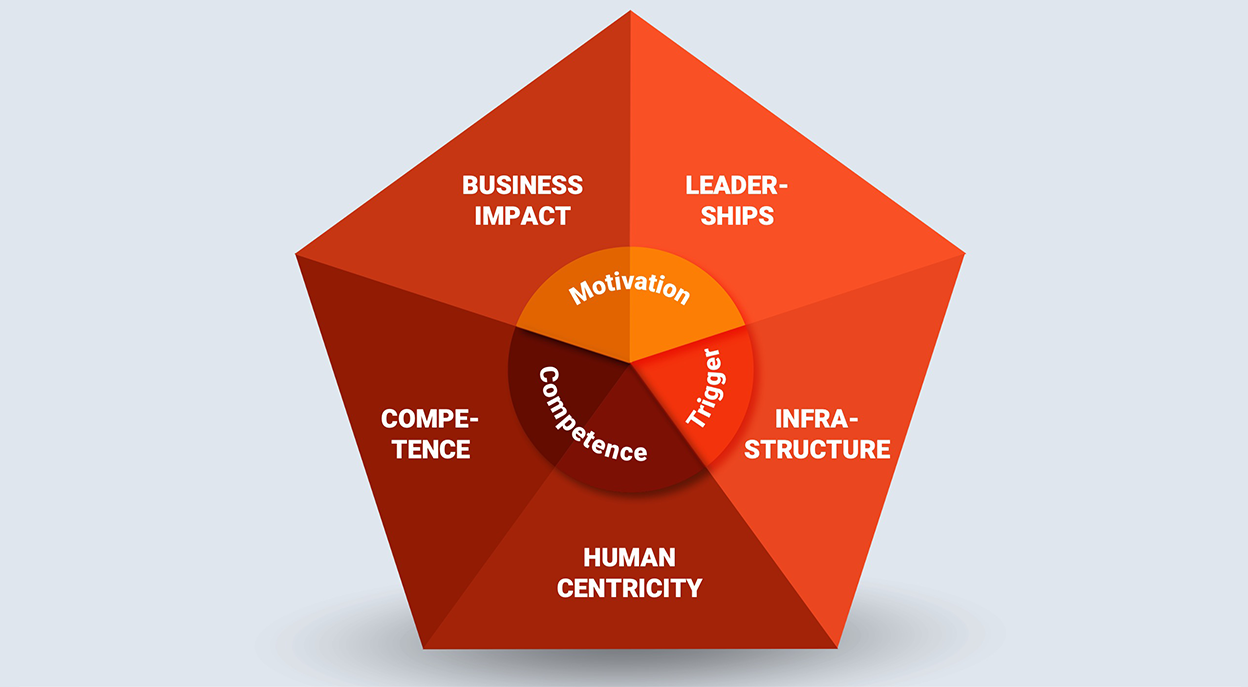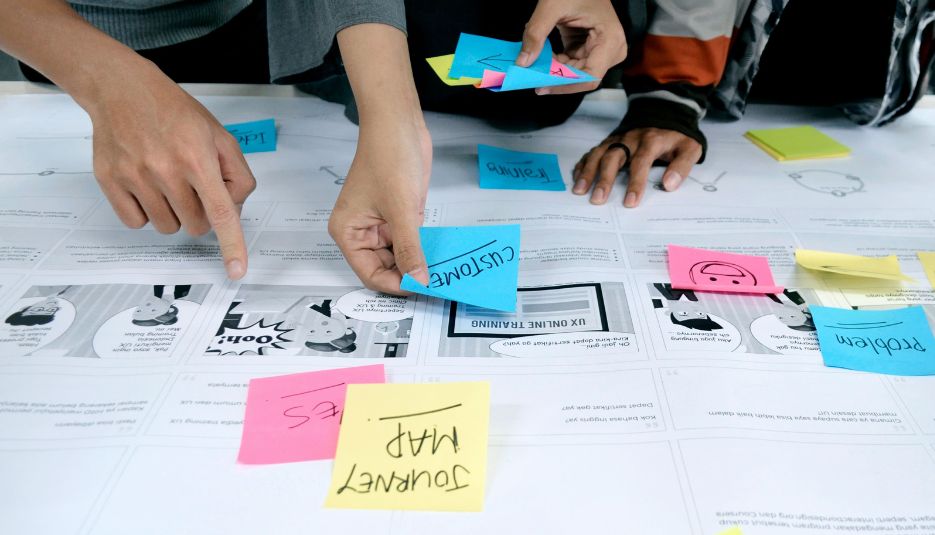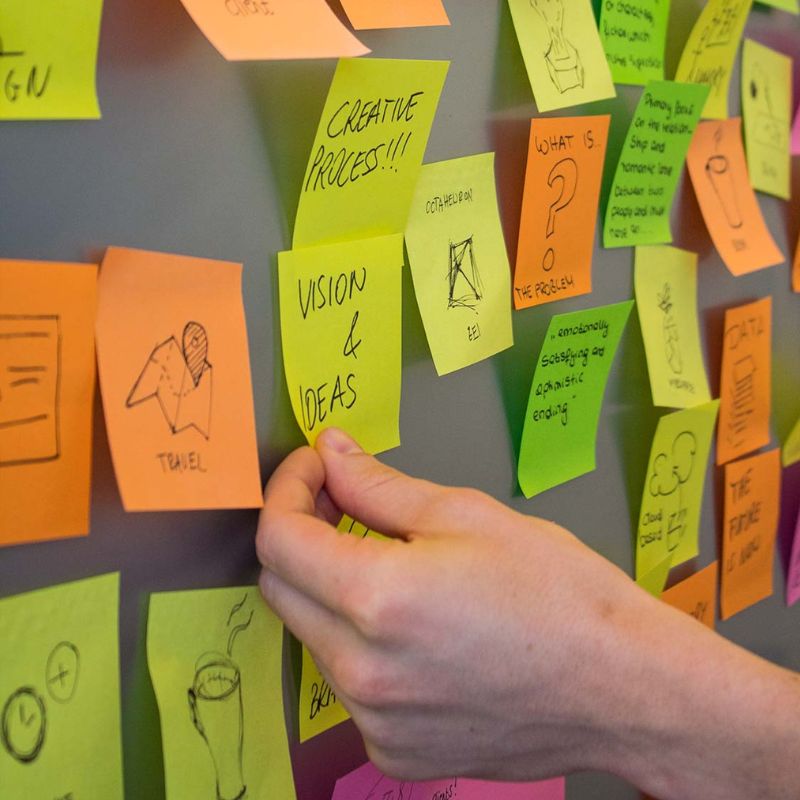26.01.2022
UX Maturity: Reif für eine menschzentrierte Digitale Transformation?
Von neuen Geschäftsmodellen über verbesserte Kundenorientierung bis zu neuen Führungsansätzen: Um die Vorteile der digitalen Transformation nutzen zu können, überdenken viele Unternehmen aktuell nicht nur ihre Produkte, sondern auch ihre Arbeitsweisen. Der Schlüssel zu einer gelungenen Transformation in die digitale Welt liegt dabei in der User Experience (UX). Doch wo steht euer Unternehmen hinsichtlich UX? Mit der Bestimmung des Reifegrads von UX, also der „UX Maturity“, legt ihr den Grundstein für die geplante und langfristige Verankerung von UX im digitalen Unternehmen – und somit die Voraussetzung für euren erfolgreichen digitalen Wandel.
Um die digitale Transformation erfolgreich zu meistern, müsst Ihr euer Unternehmen grundlegend verändern. Das erfordert einen menschenzentrierten, differenzierten Blick auf Eure Unternehmensprozesse. Immer mit der zentralen Frage: Welchen Nutzen wollt ihr aus der digitalen Transformation ziehen? Denn es geht beispielsweise nicht pauschal darum, die komplette Kundenkommunikation zu digitalisieren. Gerade B2B bleiben persönliche Kontakte wichtig. Damit die Kommunikation mit Kund:innen, Nutzenden, Mitarbeitenden und Partnern auch digital positiv erlebt wird, müssen Menschen im Fokus stehen. Der Startpunkt hierfür ist der individuelle IST-Zustand eures Unternehmens. Um diesen zu bestimmen, müsst ihr zunächst die UX Maturity eures Unternehmens kennen. Mit ihr legt ihr eine fundierte Grundlage für den digitalen Wandel.
Warum UX? Und was will UX Maturity?
Bevor ihr jedoch den Blick darauf richtet, wo ihr hinsichtlich UX steht, müsst ihr den Stellenwert von UX in eurem Unternehmen definieren. Die zentrale Frage hierbei lautet: Was wollt ihr mit UX im Unternehmen erreichen? UX bietet unterschiedliche Funktionen und je nach Markt, wirtschaftlichen Rahmenbedingungen und Wettbewerbssituation sind andere Ziele erstrebenswert: Qualitätsoptimierung, Ideengenerierung, Kundenbindung, Differenzierung vom Wettbewerb oder Präsentation der Marke. Alle Bereiche auf der höchsten Stufe zu realisieren kann eure Organisation kaum leisten – und das muss sie auch nicht! Je nach aktueller und angestrebter Marktposition erhaltet ihr ein maßgeschneidertes Anforderungsprofil mit unterschiedlichen Prioritäten bezogen auf die sechs Funktionen.
Zielgerichtete Transformation
Um euer Ziel zu erreichen, müsst ihr zunächst prüfen, ob Arbeits-, Denkweisen und Unternehmensstrukturen euch bereits dabei unterstützen. Welches Potenzial ist vorhanden? Worauf könnt ihr aufbauen? Wo müsst ihr Lücken schließen? Die Betrachtung der folgenden fünf Dimensionen zeigt euch, wie gut euer Unternehmen auf UX vorbereitet ist. Mit dem Agile UX Maturity Model bestimmen wir den Reifegrad in den unterschiedlichen Dimensionen und begleiten euren Veränderungsprozess. Damit ihr euch schnell verbessern könnt, sind wir dabei nicht auf die Bestimmung einer konkreten Stufe fixiert, sondern identifizieren vielmehr Potenziale und entwickeln handlungsorientierte Maßnahmen.

1. Warum Veränderung?
Veränderung braucht eine Wertsteigerung als Beweggrund. Die Rechtfertigung dafür liefert der angestrebte Business Impact. Dieser zeigt auf, dass und warum es sich lohnt, UX zu etablieren. Für euer Unternehmen muss transparent sein, welche Funktion UX für die Organisation erfüllt, also warum ihr UX einsetzt, um erfolgreich zu sein. Die Leitfrage lautet hier: Was könnt und wollt ihr mit UX erreichen? Ein einheitliches Verständnis davon hilft euch, Entscheidungen aus einer Hand entlang einer gemeinsamen Linie treffen zu können. Folgende Fragen helfen, die IST-Situation Eures Business Impacts zu umreißen: Können (Design-)Verantwortliche im Unternehmen klar Auskunft geben, welcher Mehrwert (oder gar USP) durch UX im Vergleich zu den Marktbegleitern entsteht? Ist dieses Wissen im Unternehmen transparent?
2. Wie wird geführt?
Führung muss im Unternehmen aktiv gelebt werden, damit Transformation ihre Wirkung in der angestrebten Weise entfalten kann. Im Fokus der Führung steht der Umgang mit jedweder Form von Einfluss – ob durch Rollen, Wissen & Kompetenz, Erfahrung oder Persönlichkeit. Die Leitfrage hierbei: Wie könnt ihr mit Führung befähigen und euren Mitarbeitenden ein menschenzentriertes Verhalten ermöglichen, das Kunden und Nutzer in den Mittelpunkt stellt? Hierbei gilt es, Kompetenzsilos zu reduzieren, mehr kompetenzübergreifende Entscheidungen herbeizuführen und diese in die Nähe von Kunden und Nutzenden zu rücken. Folgende Fragen helfen euch dabei, den aktuellen Stand zu ermitteln: Ist die Vision Ergebnis von Research und Marktdaten? Gibt es unternehmensweite Ziele? Haben einzelne Abteilungen und Projektteams Ziele? Wie werden Entscheidungen im Unternehmen getroffen (Prozess) und kommuniziert (Transparenz)?
3. Wird menschzentriert entschieden?
User Centricity umfasst die Tools und Methoden, mit deren Hilfe Ihr UX erfolgreich umsetzen könnt. Die Kernfrage lautet: Wie könnt ihr euren Mitarbeitenden ein menschenzentriertes Verhalten erleichtern, das Kunden und Nutzende in den Mittelpunkt stellt? Welche Disziplinen/Abteilungen gibt es in eurem Unternehmen? Welche Funktionen von UX- und Produktmanagement gibt es In-House? Wie divers sind die Disziplinen? Wie einfach ist beispielsweise der Zugang zu geeigneten Studienteilnehmenden für Research-Aktivitäten, um Wissen über Nutzende zu erweitern? Wie wird Wissen für die gesamte Organisation nutzbar gemacht und organisiert, um gezielt Entscheidungen zu treffen?
Das beinhaltet neben Designtools aber auch strukturelle Voraussetzungen: Sind die Touchpoints für euer Unternehmen transparent? Gibt es eine Zielgruppendefinition? Ist Kundenfeedback regelmäßig und transparent? Wird Nutzungsverhalten aus dem Feld wieder an die Entwicklung zurückgespielt?
4. Welche Ressourcen habt ihr?
Eine notwendige Bedingung für erfolgreichen Wandel ist die Befähigung. Diese umfasst einerseits Wissen, Kenntnisse und Fähigkeiten der Mitarbeitenden, andererseits die Arbeitsbedingungen, diese individuellen Kompetenzen effektiv einsetzen zu können. Neben Designtools geht es hier auch um das Arbeitsumfeld und vorhandene Ressourcen. Die Kernfrage lautet: Wie könnt ihr euren Mitarbeitenden eine menschenzentrierte Arbeitsweise erleichtern, die Kunden und Nutzer in den Mittelpunkt stellt?
5. Habt Ihr die passende Infrastruktur?
Die Motivation ist hoch, euer Wissen und eure Kompetenzen auch. Prima. Es sind jedoch auch immer Auslöser nötig, um neue Verhaltensweisen zu initiieren. Gerade in der Übergangsphase, wenn das Team noch nicht auf Gewohnheiten und Rituale vertrauen kann, seid ihr auf externe Trigger angewiesen. Die Infrastruktur schafft über Prozesse, räumliche Gegebenheiten wie Kreativecken, mit festen Strukturen und Terminen wie Dailys diese nötigen Auslöser, um Mitarbeitende zum richtigen Zeitpunkt zu den neu gelernten Verhaltensweisen zu animieren. Neben den Aktivitäten innerhalb des Prozesses sind auch die Rollen und Verantwortlichkeiten entscheidend für den Erfolg. Wie laufen eure Prozesse in der Organisation? Wie gut erlaubt der Prozess den disziplinübergreifenden Austausch? Wer ist beteiligt? Wie arbeiten die verschiedenen Stakeholder zusammen?
Die Zeit ist reif? – Los geht’s!
Indem ihr eure UX-Ziele definiert, priorisiert und den IST-Zustand bestimmt, legt ihr den Grundstein eurer individuellen Roadmap Richtung mehr Experience Design – und sichert den Erfolg eurer digitalen Transformation. Ist der UX-Reifegrad umrissen, beispielsweise mit einem User Centricity Workshop, könnt ihr Teilziele für das erste Jahr ableiten. Ein erster Schritt liegt dann in der Praxis meist darin, innerhalb eures Unternehmens ein Dringlichkeitsbewusstsein (im Sinne des „sense of urgency“ nach John Kotter) für die erklärten Ziele und Funktionen zu schaffen.
Als UX-Pionier der ersten Stunde begleiten wir eure digitale Transformation. Wir zeigen euch, wie ihr die Nutzerperspektive stärker integrieren und agiles, menschenzentriertes Denken auf allen Ebenen eures Unternehmens verankern könnt. Damit ihr die Vorteile der digitalen Transformation leben könnt. Seid Ihr bereit?
Die Autor:innen
Dr. Jan Seifert
Als Lead User Experience bei UID verfügt Jan über umfassende Erfahrung in allen Phasen der menschenzentrierten Entwicklung. Je nach Projektanforderung führt der Diplom-Psychologe den Prozess selbst durch, leitet ihn an oder implementiert ihn. Sein Wissen und seine praktische Erfahrung gibt Jan in Vorträgen und Vorlesungen weiter.
Kathrin Seigel
Ob Social Media, PR-Konzept, Journalistenanfrage oder Messeorganisation – Kathrin gestaltet mit dem Team der Corporate Communications die Kommunikation von UID. Als Diplom-Pädagogin, Kommunikationswissenschaftlerin und Nordlicht im Team lautet ihr Motto „Wir können alles. Und Hochdeutsch!“










